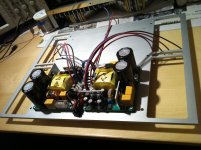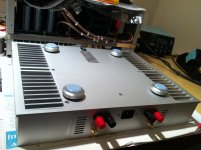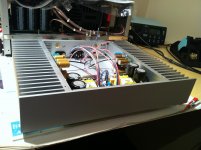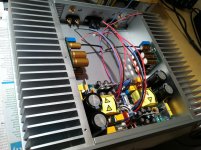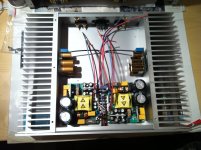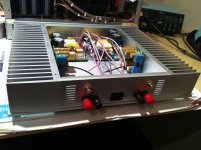@Salas:
Some time ago (~10yrs) it occurred to me that amplifiers in moderately heavy daily use see similar conditions to some commercial equipment that also uses electrolytic caps in similar ways... I am not one to just sit on an idea... Soooo... I persuaded a customer to buy audio grade caps from a couple different suppliers, and put them on cycle test alongside the standard industrial/commercial low ESR caps. Time and temperature cycle, ripple at about specified levels, power on/off cycle.
The results were awful, bad to the point of embarrassment.
Although the audio caps met their published spec for a short time, they had a much greater variance from the start and during test, and their measured performance went down steadily in relation to temperature and power cycles. Most are rated at a very short life compared to commercial grades, lower temperature spec, and not rated for power cycle at all.
At the time I estimated that if you turn an amplifier on and off twice per day (like an hour in the morning and a few hours at night), the typical audio cap will be out of spec at the end of 15 months, and close to failure (defined as 40% variance) in 30. Worse, you can't assume capacitors in the same position on opposite rails will change at the same rate...
None of this shows anything about how an amp sounds while the caps are in spec, but it does explain why some people report an improvement when they replace caps in gear that has been used for a while on a daily basis, or when a cap that has been on the shelf for a while is replaced with one fresh from the factory...
Some time ago (~10yrs) it occurred to me that amplifiers in moderately heavy daily use see similar conditions to some commercial equipment that also uses electrolytic caps in similar ways... I am not one to just sit on an idea... Soooo... I persuaded a customer to buy audio grade caps from a couple different suppliers, and put them on cycle test alongside the standard industrial/commercial low ESR caps. Time and temperature cycle, ripple at about specified levels, power on/off cycle.
The results were awful, bad to the point of embarrassment.
Although the audio caps met their published spec for a short time, they had a much greater variance from the start and during test, and their measured performance went down steadily in relation to temperature and power cycles. Most are rated at a very short life compared to commercial grades, lower temperature spec, and not rated for power cycle at all.
At the time I estimated that if you turn an amplifier on and off twice per day (like an hour in the morning and a few hours at night), the typical audio cap will be out of spec at the end of 15 months, and close to failure (defined as 40% variance) in 30. Worse, you can't assume capacitors in the same position on opposite rails will change at the same rate...
None of this shows anything about how an amp sounds while the caps are in spec, but it does explain why some people report an improvement when they replace caps in gear that has been used for a while on a daily basis, or when a cap that has been on the shelf for a while is replaced with one fresh from the factory...
I mainly use Panasonic FR nowadays. They have the same low ESR then FM but have double the life span. They are very affordable and i can get them from Reichelt in a day.
Never had any " Soundquality" issue with those.
I know, because Andrejs heavy tube PSU pimped Paradise sounded totally different ( i thought better ) then the standard implementation.
Both used FR. I simply do not trust what i read on the web any more.
Some say Silmik sound the best and Rubicon ZL sound harsh and some say Panasonic FM
are considerably more dynanic then the dark and tired sounding Silmik.
No measurements of cause. It is pathetic or should i say pathological.
Never had any " Soundquality" issue with those.
I know, because Andrejs heavy tube PSU pimped Paradise sounded totally different ( i thought better ) then the standard implementation.
Both used FR. I simply do not trust what i read on the web any more.
Some say Silmik sound the best and Rubicon ZL sound harsh and some say Panasonic FM
are considerably more dynanic then the dark and tired sounding Silmik.
No measurements of cause. It is pathetic or should i say pathological.
I used FR in my poor-man's through-hole version of VSSA/PeeCeeBee.I mainly use Panasonic FR nowadays. They have the same low ESR then FM but have double the life span. They are very affordable and i can get them from Reichelt in a day...
I hope to compare to LC's boards within a week, using the caps he recommended. I try to follow directions first time I build someone else's design, on the theory that making changes before having anything to compare is a bad idea, at least for someone with limited knowledge (tested that theory thoroughly...
I have noticed far bigger dependency on power supply quality than what I expect to see using different on-board caps (assuming similar ESR etc).
I know what you are thinking, a few dozen BG's and other rare caps to play with... poor me@PMI
Was it Elna & Blackgates?
BG's were part of the test, can't remember all of them or which did better than others. If I do, the BGs started out well, but not so good over time, or after repeated on-off cycle with temperature. They did mostly ok, at steady temps that would correspond to internal chassis temperature for equipment kept on all the time. On/off seemed especially detrimental, ironic for components recommended for home use where power is cycled potentially several times per day. I think they did ok on the ripple tests, but it was all a long time ago.
What bothered me especially, the findings totally trashed my personal beliefs about comparing audio gear.
What I mean is this: say you own an amp or preamp, and want to try an upgrade... and say your friend owns the same unit. So, you swap a few parts, thinking you will do you own "blind" listening test, original v. modded unit... but the stock unit has been used for a year or more! (I think you see where this is going)
Should the ALF touch the PCB by one side?
Text (upper) side of ALF touches PCB completely. Before even start soldering, it has to be fixed with M3 screw/nut firmly to the PCB, than soldering is in order.
Guys, today's capacitors topic was the reason not to include capacitors in VSSA PCB set. Impressions which brand to use are so subjective that I simply left the decision to each individual. 
I set firmly the values since these are calculated and very important to consider. Also 10 uF MKT is of utmost importance to be in the circuit, tested at MHz bandwidth region.
I also had FM in the feedback but FG simply present the vocals and the whole midrange spectrum more acurately.

I set firmly the values since these are calculated and very important to consider. Also 10 uF MKT is of utmost importance to be in the circuit, tested at MHz bandwidth region.

I also had FM in the feedback but FG simply present the vocals and the whole midrange spectrum more acurately.

Yesterday me and a friend listened to a small system: NAIM SuperUniti as a source, THIEL CS2.4SE loudspeakers and VSSA amp. System was so musical that friend of mine almost didn't allow me to left the building. Speakers are 4 Ohm nominal impedance, deeps down to 3 Ohm and have low efficiency of 87 dB/W/m. VSSA was warm, almost hot, but manage to deal with the speakers, it probably gave 150 Watts or something, with ease and comfort in musical presentation.
More important than caps topic is, but nobody commented upper post, that VSSA is clearly capable to drive speakers as THIEL CS2.4E are. Look their specs and you'll clearly see that these are not very comfortable load to any amp to handle.
Modern configs as always.
Few pics of a new VSSA case, dual mono design with SMPS400A180 naturally.
Attachments
Few pics of a new VSSA case, dual mono design with SMPS400A180 naturally.
Tre cool
Similar three way speakers only that Quadral uses rear bass reflex port. VSSA will be perfect match to Shogun-s.I have used a singleton Magnat All-ribbon 6, this 3-way speaker is quite revealing. My main speaker is a pair of Quadral Shogun Mk.3 (the one with the ribbon tweeter).

Thanks, very good remark, I'll put it in a manual.One point that I want to add is:
After step 3 on page 2, Clean the solder flux off the top pcb layer BEFORE soldering the capacitors.

I know, because Andrejs heavy tube PSU pimped Paradise sounded totally different ( i thought better ) then the standard implementation. Both used FR.
Yes Panasonic EE industry standard elcos in SMPS's primary side (huge ripple current data and energy storage) and Panasonic FR on secondary 100 KHz side, no mambo jumbo here just pure measurement performance in stake.

BTW how's your VSSA build coming together?
Member
Joined 2009
Paid Member
@Salas:
Some time ago (~10yrs) it occurred to me that amplifiers in moderately heavy daily use see similar conditions to some commercial equipment that also uses electrolytic caps in similar ways... I am not one to just sit on an idea... Soooo... I persuaded a customer to buy audio grade caps from a couple different suppliers, and put them on cycle test alongside the standard industrial/commercial low ESR caps. Time and temperature cycle, ripple at about specified levels, power on/off cycle.
The results were awful, bad to the point of embarrassment.
In my recent builds I use non-audio caps near the rectifier and audio grade just before the amplifier. Between them I have inductor and/or resistor.
The sound of distortion :
http://web.archive.org/web/20070622....com/soundcards/techtalk/dist_sound/index.htm
http://web.archive.org/web/20070622....com/soundcards/techtalk/dist_sound/index.htm
- Home
- Vendor's Bazaar
- VSSA Lateral MosFet Amplifier
